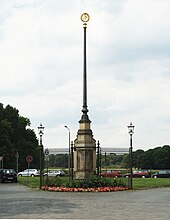Rosental (Leipzig)
The Rosental is a 118 hectare park-like part of the northern Leipzig floodplain forest . It is bounded by the Elstermühlgraben in the south and west, the Parthe in the north and the Leipzig Zoo in the east.
history

The name Rosental was first mentioned in a document in 1318. From the possession of the Saxon electors, the former economic forest was sold on September 1, 1663 by Elector Johann Georg II. To the Leipzig council. Since the agreed purchase price of 17,142 guilders was offset against the elector's debts to the city, the seller only had an amount of less than 6,000 guilders. His grandson August the Strong later challenged this deal and accused the Leipzig council of having sneaked the contract. As a result, the council had to start redesigning the Rosental from the end of November 1707 according to a plan by Johann Christoph von Naumann . The large meadow and thirteen radial, mostly pathless visual aisles (six are still visible today) were cut into the Rosental. The aisles were aimed at interesting points in the area. The plan also provided for an elaborate el-axis palace complex at its intersection. However, since the financing of the buildings was supposed to come from the city of Leipzig's treasury, the council tried to prevent their construction by referring to summer mosquito plagues, regular floods and the alleged threat from robber gangs. In the end, only a wooden observation tower was built. However, this was actively used by August the Strong during his stays in Leipzig.
In 1777, at the suggestion of Hofrat Johann Gottlob Böhme, the Dammweg was laid out, the first promenade through the Rosental. It led from Gohlis to the Rosentaltor and was upgraded for visitors in 1782 and 1824 with the opening of two cafés (the Schweizerhäuschen and the Café Bonorand ).
The current park-like design was given to the Rosental by the horticultural artist Rudolph Siebeck from 1837. An irregular network of paths and new plantings took away the strict layout of the park.
On its east side, the Rosental lost a large area due to several expansions of the Leipzig Zoo . However, with the last expansion and the associated completion of the so-called zoo showcase in 1976, a broad rift line between the zoo and the Rosental, an insight into the zoo's animal population and a view of the Rosental landscape for zoo visitors is possible.
There is an artificial hill in the north-west of the Rosental. In the years 1887 to 1896, 120,000 m³ (60,000 horse-drawn vehicles) of household rubbish were dumped here on the 20 m high Rosental Hill ("Scherbelberg"). This was greened from 1895 and built on in 1896 with a 15 m high, wooden observation tower based on a design by Hugo Licht . The tower burned down completely in the wake of the heavy bombing on December 4, 1943 . Since 1975 there has been a new steel construction, 20 m high observation tower.
At the northwestern end of the Rosental is the Rosental sewage treatment plant of the Leipzig municipal waterworks , the central wastewater treatment facility of the city of Leipzig.
The origin of the name Rosental is still unclear today. In 1714, the chronicler Johann Jacob Vogel wrote in the Leipzig Chronicon :
"The Rosental has the name of graceful, shady and funny walks, just as other funny and pleasant places lead the name of paradise, or like vineyards to Jena, this side of the river Saale, because of the gracefulness, the rose mountains are called"
In the German dictionary of the Brothers Grimm , the origin is assumed to be a Slavic word:
“Often as a place name. the famous rosenthal near Leipzig (see ALBRECHT 193b), however, a city forest, has nothing to do with rose, but is possibly a folk etymological distortion of the slav. rozdot, hollow, deep and wide depression. "
literature
- Friedrich Hofmann : The Leipzig Rosenthal . In: The Gazebo . Issue 29, 1884, pp. 484, 485, 487 ( full text [ Wikisource ]).
- Wolfgang Hocquél: Leipzig - Architecture from the Romanesque to the present . Passage-Verlag, ISBN 3-932900-54-5
Web links
Individual evidence
- ↑ Rosentalhügel and observation tower on the website of the city of Leipzig
- ↑ Rosenthal. In: Jacob Grimm , Wilhelm Grimm (Hrsg.): German dictionary . tape 14 : R - skewness - (VIII). S. Hirzel, Leipzig 1893, Sp. 1222-1223 ( woerterbuchnetz.de ).
Coordinates: 51 ° 21 ′ 0 ″ N , 12 ° 21 ′ 49 ″ E







